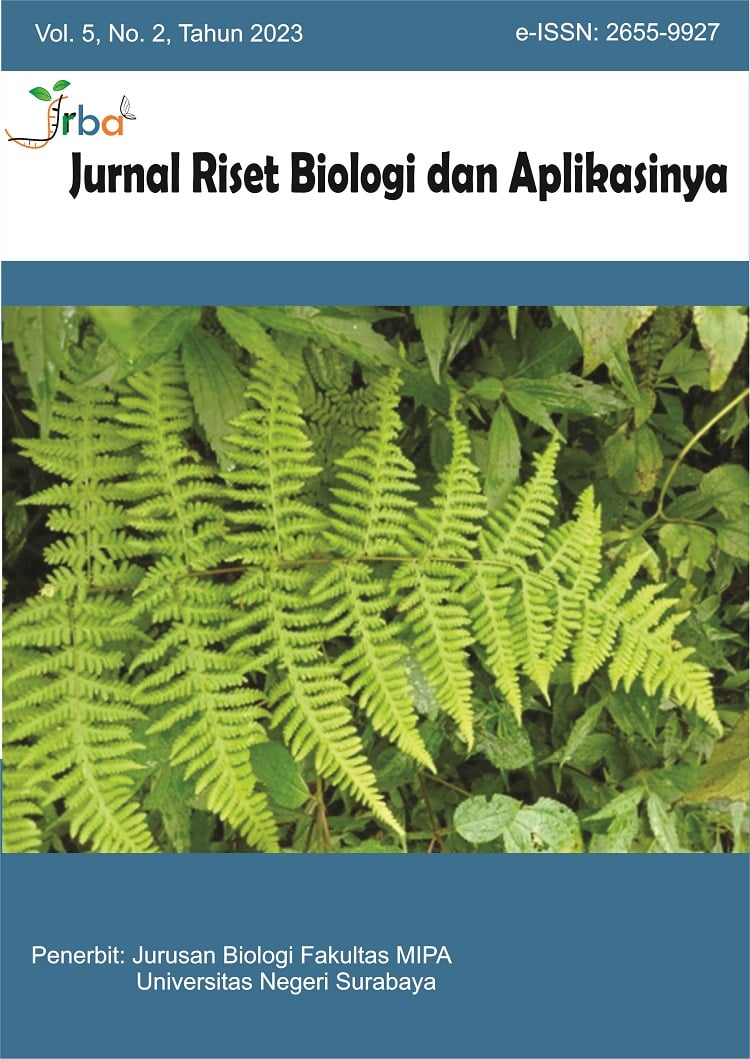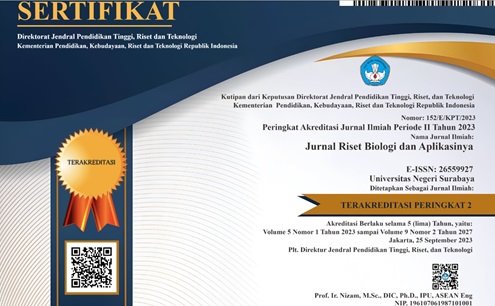Chronic Toxicity Effect of Mimosa pudica Leaf Extract Towards Histology Profile of Stomach and Duodenum in Mice
DOI:
https://doi.org/10.26740/jrba.v5n2.p52-59Abstract
In Indonesia, Mimosa pudica Linn. (M. pudica L.) is a wild plant (weed) from the Mimosaceace family. This plant is widely used as a traditional medicine for various types of diseases such as insomnia, acute eye inflammation, urolithiasis (urinary stones), fever, and bronchitis. This study aimed to find out the effect of M. pudica leaf extract on the histological damage of the stomach and duodenum of mice. This study used a Completely Randomized Design with 24 male mice, which were divided into control placebo (P0) given CMC-Na 0.5%; and M. pudica leaf extract doses of 200 mg/kg body weight (P1); 400 mg/kg body weight (P2); and 600 mg/kg body weight (P3). The extract was administered orally for 28 days. On day 29, the animal was dissected to collect its digestive organs. The histological preparation of the stomach and duodenum of mice was performed by using the paraffin method and Hematoxylin and Eosin staining to observe the histological damage, namely congestion, hemorrhage, epithelial cells desquamation, inflammatory cell infiltration, edema, and hyperplasia. Quantitative data were analyzed with a one-way ANOVA test and Duncan's post hoc test with the SPSS version 22. The results showed that the M. pudica leaf extract increased hemorrhage and hyperplasia damage at doses of 400 and 600 mg/kg body weight in mice’s duodenum.
References
Assiam, N., Setyawati, I., & Sudirga, S.K. (2014). Pengaruh dosis dan lama perlakuan ekstrak daun kaliandra merah (Calliandra calothyrsus Meissn.) terhadap struktur histologi ginjal mencit (Mus musculus L.). Jurnal Simbiosis, II(2), 236-246. https://ojs.unud.ac.id/index.php/simbiosis/article/view/9782
Berata, IK., Winaya, B.O., Adi, A.A.M., & Adnyana, I.B.W. (2015). Patologi veteriner umum. Denpasar: Swasta Nulus.
Cahyaningsih, R., Brehm, J.M., & Maxted, N. (2021). Setting the priority of medicinal plants for conservation in Indonesia. Genetic Resources and Crop Evolution, Netherlands: Springer. https://doi.org/10.1007/s10722-021-01115-6
Chen, L., Deng, H., Cui, H., Fang, J., Zuo, Z., Deng, J., Li, Y., Wang, X., & Zhao, L. (2017). Inflammatory responses and inflammation-associated diseases in organs. Oncotarget, 9(6), 7204-7218. doi: 10.18632/oncotarget.23208
Diwan, F.H., Abdel-Hassan, I.A., & Mohammed, S.T. (2017). Effect of saponins on mortality and histopathological changes in mice. Eastern Mediterranean Health Journal, 6(23), 345-351. https://pubmed.ncbi.nlm.nih.gov/11556022/
Ekor, M. (2014). The growing use of herbal medicines: issues relating to adverse reactions and challenges in monitoring safety. Front Pharmacol., 4, 177. https://10.3389/fphar.2013.00177
Hammer, G.D., & McPhee, S.J. (2019). Pathophysiology of disease: an introduction to clinical medicine. Eight editions. USA: Lange Medical Book
Hehi, K.H., Loho, L & Durry, F.M. (2013). Gambaran histopatologi lambung tikus wistar pasca pemberian metanol. Jurnal E-Biomedik, 1(2), 890-895. 10.35790/ebm.1.2.2013.5475
Joseph B., George, J., & Mohan, J. (2013). Pharmacology and traditional uses of M. pudica. International Journal of Pharmaceutical Sciences and Drug Research, 5(2), 41-44. https://ijpsdr.com/index.php/ijpsdr/article/view/239
Mensah, M.L.K., Komlaga, G., Forkuo, A.D., Firempong, C., Anning, A.K., & Dickson, R.A. (2019). Toxicity and safety implications of herbal medicines used in africa. IntechOpen. 10.5772/intechopen.72437
Pearce, E.C. (2016). Anatomi dan fisiologi untuk paramedis, Cetakan ke-29. Jakarta: PT. Gramedia Pustaka Utama
Pramesti, T.K., Wiratmini, N.I., & Astiti, N.P.A. (2017). Struktur histologi hati mencit (Mus musculus L.) setelah pemberian ekstrak daun ekor naga (Rhapidhopora pinnata Schott). Jurnal Simbiosis, 3(2), 43-46. https://doi.org/10.24843/JSIMBIOSIS.2017.v05.i02.p02
Putra, H.H., Wibowo, M.H., & Kurniasih, T.U. (2012). Studi lesi makroskopik dan mikroskopik embrio ayam yang diinfeksi newcastle disease virus field isolates. Jurnal Sain Veteriner, 30(1), 50-67
Ranjan, R.K., Sathish, K., Seethalakshmi & Rao, M.R.K. (2013). Phytochemical analysis of leaves and roots of Mimosa pudica collected from Kalingavaram, Tamil Nadu. Journal of Chemical and Pharmaceutical Research, 5(5), 53-55
Ratnasari, D., Wiratmini, N.I., & Setyawati, I. (2019). Gambaran histologi saluran cerna dan aktivitas hati tikus putih (Rattus norvegicus) yang diberi ransum tepung daun lamtoro (Leucaena leucocephala Lamk. de Wit) hasil perendaman [thesis], Denpasar: Unud
Setyawati, I., Putra, IG.N.A.D., & Roni, N.G.K. (2017). Histologi tubulus seminiferus dan kadar testosteron tikus yang diberi pakan imbuhan tepung daun kaliandra dan kulit nanas. Jurnal Veteriner, 18(3), 369-377.https://doi.org/10.19087/jveteriner.2017.18.3.369
Sudiono, J. (2014). Sistem kekebalan tubuh. Jakarta: PT EGC
Tarung N.F. (2015). Pengaruh ekstrak herba putri malu (Mimosa pudica L.) pada histologi organ mencit betina sebagai penunjang uji toksisitas subkronis [skripsi], Surabaya: Universitas Katolik Windaya Mandala
Wuragil, L.R. (2007). Gambaran histopatologi pencernaan tikus pada pemberian fraksi asam amino non-protein dan fraksi polifenol lamtoro merah (Acacia villosa). Bogor: Institut Pertanian Bogor
Downloads
Published
How to Cite
Issue
Section
License
Copyright (c) 2023 Jurnal Riset Biologi dan Aplikasinya

This work is licensed under a Creative Commons Attribution-NonCommercial 4.0 International License.
 Abstract views: 456
,
Abstract views: 456
, PDF Downloads: 711
PDF Downloads: 711












